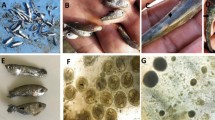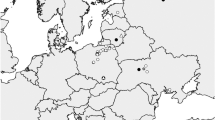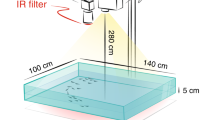Abstract
IT is well known that the larval trematode “Diplostomum volvens Nordmann, 1832” may cause impaired vision, and even blindness, in certain fishes. Rushton1 and Baylis2 have reported the presence of this diplostomulum in the eyes of rainbow trout in Britain. The presence of 20–40 parasites in the lens of each eye may favour completion of the life-cycle, because the fish then falls an easier prey to water birds. The definitive hosts of this trematode, Diplostomum spathaceum (Rudolphi, 1819), are various species of gulls, and the usual location is the intestines3.
This is a preview of subscription content, access via your institution
Access options
Subscribe to this journal
Receive 51 print issues and online access
$199.00 per year
only $3.90 per issue
Buy this article
- Purchase on SpringerLink
- Instant access to full article PDF
Prices may be subject to local taxes which are calculated during checkout
Similar content being viewed by others
References
Rushton, W., Nature, 140, 1014 (1937); 141, 289 (1938).
Baylis, H. A., Proc. Linn. Soc. Lond., 151, 130 (1939).
Dawes, B., “Trematoda” (Camb. Univ. Press, 1946).
Szidat, L., Zool. Anz., 58, 303 (1924).
Szidat, L., Zool. Anz., 61, 249 (1924).
Wesenberg-Lund, C., D. Kgl. Dansk. Vidensk. Selsk. Skrifter, Naturv. Math. Afd., Raekke 9, 5 (3), 151 (1934).
Author information
Authors and Affiliations
Rights and permissions
About this article
Cite this article
DAWES, B. Trematode Life-Cycle enacted in a London Pond. Nature 170, 72–73 (1952). https://doi.org/10.1038/170072a0
Issue date:
DOI: https://doi.org/10.1038/170072a0



